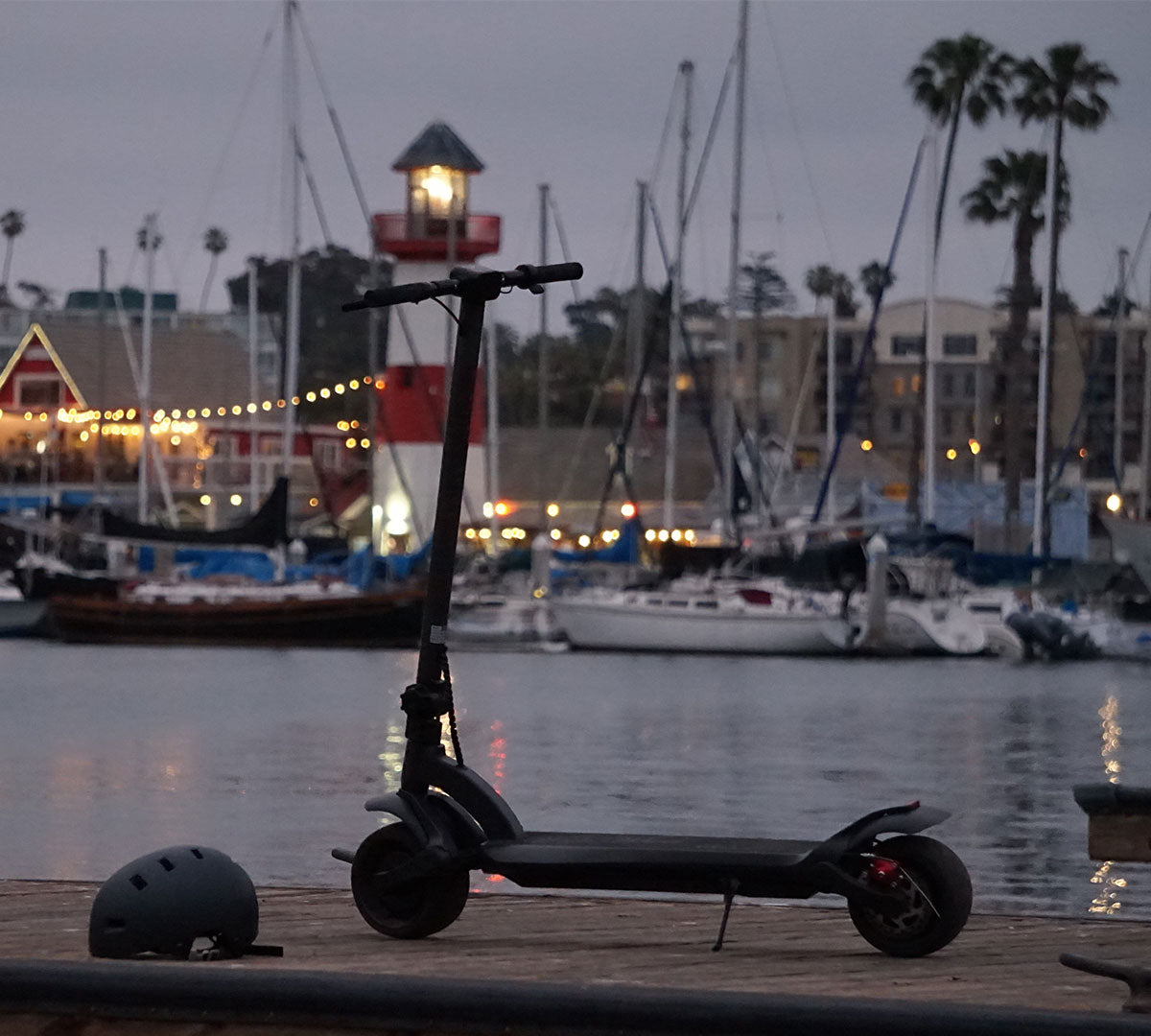The Complete Guide to Electric Scooter Batteries
- Read Time: 13 min
The battery is the powerplant of your electric scooter. Storing all the energy needed for propulsion, controllers, lights, etc.
Lithium-ion batteries are the go-to for the industry as of late. They have great energy density and are long-lasting. Kids' scooters and cheaper models might have lead-acid batteries.
Another important part of the battery is the BMS (Battery Management System) which is a sort of "brain" for the battery making sure it operates as it should and is protected as well.
The bigger the pack, the bigger the numbers, and the more the capacity measured in Watt-hours. All this will increase range, speed, and overall power. But it will also mean a heavier weight.
The battery pack is one of, if not the most expensive part of an electric scooter, and the better bigger the pack, the more it costs.
Let's dig in and find out all you need to know about electric scooter batteries.
Lithium-Ion Battery

A lithium-ion (Li-ion) battery is an advanced battery technology that uses lithium-ions as a key component of its electrochemistry. Li-ion batteries can use several different materials as electrodes.
The most common combination is typically one found in laptops and cellphones. Lithium cobalt oxide (cathode) and graphite (anode). Other versions are:
- Lithium manganese oxide, aka IMR, LMO, Li-manganese
- Lithium manganese nickel, aka, IMR, NMC
- Lithium nickel cobalt aluminum oxide, aka, NCA, Li-aluminum
- Lithium nickel cobalt oxide, aka, NCO
- Lithium cobalt oxide, aka, ICR, LCO, Li-cobalt
- Lithium iron phosphate, aka, IFR, LFP, Li-phosphate
Lithium-ion batteries have one of the highest energy densities of any battery existing today. They can also deliver three times higher amounts of energy than f.e. technologies like Ni-Cd (Nickel-Cadmium) or NI-MH (Nickel-Metal hydride).
They are very low maintenance and don't require scheduled cycling to maintain battery life. Lithium-ion batteries also have no memory effect which is a detrimental process where repeated partial charge and discharge cycles can cause a battery to "remember" a lower capacity.
They can be charged many times without losing power. These are some of the advantages that have made Li-ion batteries market leaders in portable electronic devices.
Despite their promise, they are not faultless though. Lithium-ion batteries tend to overheat and can be damaged at high voltages. They require safety mechanisms to limit internal pressure and voltage. This can sometimes increase weight and limit performance. They are also subject to aging and will lose capacity and start failing after several years.
Lithium Manganese, (INR, NMC) Battery
Lithium Manganese Nickel is a safe version of a high-capacity, output current battery. Many electric scooters are equipped with this type of battery.
The benefits of NMC batteries include high energy density and a longer lifecycle at a lower cost than cobalt-based batteries. They also have higher thermal stability than LCO batteries, making them safer overall.
Typically found in power tools, electric scooters, and e-bikes.
The drawback is that they have a slightly lower voltage than cobalt-based batteries.
Lead-acid Battery
Think of a car battery. That's your typical lead-acid battery. They have the benefit of being inexpensive but, suffer from poor energy density and thus, weigh a lot compared to the amount of energy they can store. We find them in vehicles such as golf carts, forklifts, and e-scooters for kids. Li-ion batteries have about 10X the energy density compared to a lead-acid version.
But they are reliable and one of the most commonly used forms for many rechargeable battery applications, f.e. when starting a car.
Battery Packs

If the combustion engine with its fuel injection system is the heart and power source of a car, so is the battery pack with its Battery Management System (BMS) for the electric scooter.
It is a crucial part of the vehicle and knowing a bit about them can help one understand the technology.
It is called a pack because many individual cells are bundled together in a brick-like pattern or structure. This can be done either in a parallel or series pattern.
The battery pack is, in turn, being monitored and controlled by an electronic circuit called the battery management system (BMS), which controls a lot of what is going on in the pack. It is in effect, the "brain" of the battery.
The BMS is responsible for:
- Monitoring the battery
- Providing battery protection
- Estimating the battery’s operational state
- Continually optimizing battery performance
- Reporting operational status to external devices
The connecting of individual cells in series sums up the voltage. This is how it is possible to have scooters with 36,48,52,60 Volt and even more.
The series of individual strands are then connected in parallel to further increase output. Manufacturers can increase the output voltage or max current in the scooter's battery by adjusting the numbers of cells in series or parallel.
Voltage Sag

You will at some point notice what is referred to as voltage sag. F.e. when you start up your e-scooter.
When you activate your battery and there is a power demand, the voltage will drop immediately. You might think you just lost a lot of power if you check your battery voltage, but once the load is removed, the true level will be indicated.
The reason for this can be different factors. Starting up a motor draws more energy, electrical resistance of some sort, temperature variations, and sometimes there is a faulty component.
Draining the battery completely can also cause this. It takes some time for the lithium in the battery to catch up with the discharge rate. That's why the voltage drops quicker the longer you ride.
Letting the scooter battery rest will return it to its true voltage level.
Capacity Rating
Electric scooter batteries are rated in units of watt-hours which expresses the average amount of current it releases over a period of time under normal use. This means that a battery with a rating of 200 Ah can deliver 20 amps of power at a constant rate for 10 hours.
More energy capacity results in higher battery watt-hours which in turn results in longer-range capacity for a certain motor type.
The average electric scooter today will typically have about 250 Wh capacity, have a range of approximately 10 miles (16 km) at an average speed of 15 mph (24 kph).
Extreme electric scooters can have thousands of watt-hours and 50+ miles of range.
Battery Brands

At the time of writing, there are but a handful of well-known companies that manufacture Li-ion cells for electric scooters. In no particular order, the highest quality cells are made by, Samsung, Panasonic, Sony, and LG.
This is the reason you will most likely find one of these on higher-end electric scooters.
Further down the list of budget electric scooters is where most of the time, Chinese manufactured generic cells of various quality can be found.
When choosing an electric scooter, make sure to check the battery pack and who the manufacturer is. The known brands have higher quality control and guarantee in place.
C Rate
As far as battery capacity goes, the C-rate tells us the speed of charging and/or discharging a battery. If a battery has a C-rate of 1C, it means the battery will be fully charged in one hour. 2C means it takes 0.5 hours, O.5 C means it takes two hours, and so on.
It also means a fully charged battery with a capacity of 10Ah should be able to provide 10 Amps for one hour. The same 10Ah battery being discharged at a C-rating of 0.5C will provide 5 Amps over two hours. And if discharged at a 2C rate it will provide 20 Amps for 30 minutes.
The C-rating is important to know as with most batteries the available stored energy depends on the speed of the charge and discharge currents.
Battery Life
A typical lithium-ion battery will have around 300-500 charging/discharging cycles before you will sense a diminished capacity. Depending on how you use your electric scooter, for an average version, this would be good for approximately 3K-10K miles.
Once it starts to diminish, it is not uncommon for it to lose 10-20% of its capacity which will continue to decline. As we are accustomed to with our cellphones.
The modern battery management systems will do what they can to prolong battery life but there are still some things you can do to help.
- Never store your scooter for longer periods with the charger plugged in or with the battery fully charged.
- Never use or activate the battery pack below 32°F (0°C) or above 113°F (45°C).
- Charge your scooter at a lower speed. I.e. at a lower C-rate. Charging the battery at a lower rate than its maximum capacity allows prolongs battery life.
- Never store your electric scooter fully discharged. Lithium-ion batteries degrade when they drop below 2.5V. The common recommendation is to store it at 50% capacity and then make sure to top up to 50% when needed. This is specifically important for long-term storage. So if you live in an area where you have snow and rain or really bad weather during the winter season. Make sure to do this properly.
Battery packs don't last forever. Yet. But as mentioned above, taking care of it will prolong battery life. The worst thing for a battery is hard discharges and recharges, excessive short charges, and over-discharging. Less aggressive riding results in gentler discharging. You empty the bottle slower and more controlled would be an analogy we all can relate to.
Keeping battery charge maintenance between 10-90% and with good temperature management will significantly increase the battery capacity.
Signs of a Worn or Failing Electric Scooter Battery
The first thing you will notice in a worn battery is that the range shortens. Over time with an aging battery, the cells become less efficient at holding the charge and the nominal capacity will drop.
You will notice the scooter's range reduces steadily but increases progressively.
Battery sag starts appearing. A temporary drop in performance when a load is applied.
When battery capacity is at 30% or less you might experience rapid drops in voltage. Sudden shut-offs at 20%. Here is where the display/battery indicator might confuse you as it shows a voltage correlating to the state of charge, whereas the true capacity of the battery is depleted due to worn cells.
Takes a long time to charge. Chargers indicating full charge too early.
BMS (Battery Management System) shuts off when the scooter is under load.
In Short
Take proper care of your battery. Read the instruction manual and don't expect it to accept whatever you throw at it. This will increase the battery's lifespan.












